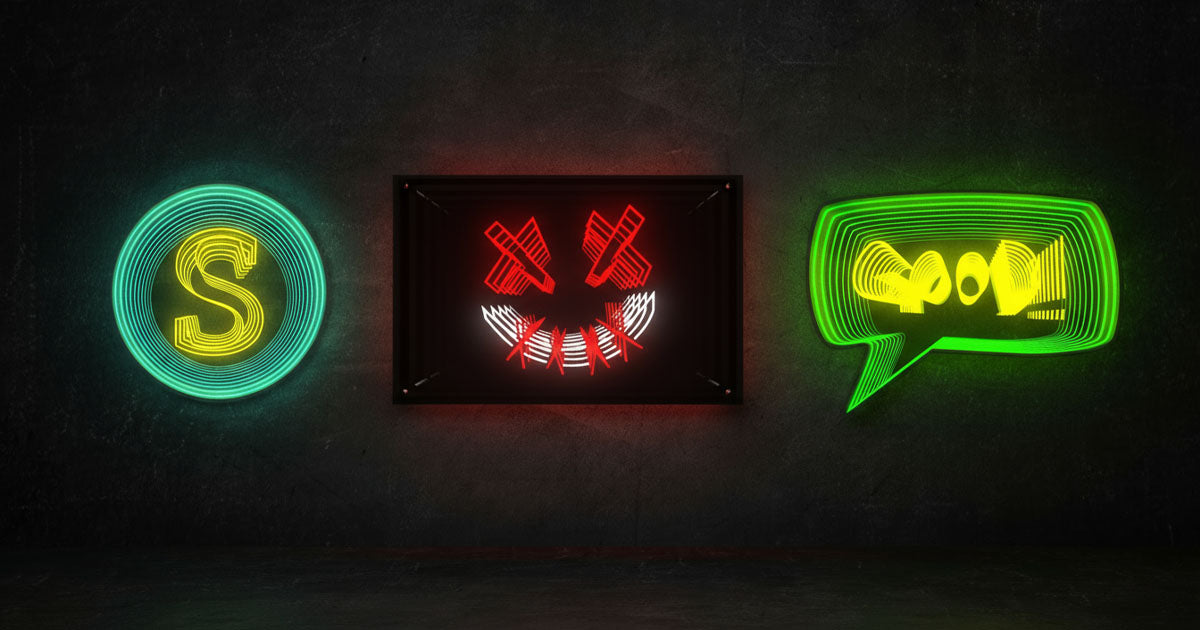 Proper installation is important for your neon sign's aesthetics look and functionality. A properly installed sign enhances its aesthetics and ensures safety and durability.
Proper installation is important for your neon sign's aesthetics look and functionality. A properly installed sign enhances its aesthetics and ensures safety and durability.
In this guide, we will walk you through the step-by-step process of installing a neon sign, covering other installation tips and troubleshooting such as:
-
Unbox your neon sign and check for damages before installation.
-
Selecting an ideal location for visibility and safety.
-
Understanding different types of neon signs and mounting methods.
-
Safety considerations during your neon sign installation.
This complete neon installation guide gives you hands-on experience in carefully and effectively hanging a neon sign.
You will also find troubleshooting tips for common problems during the neon installation
Preparing for Your Neon Sign Installation
Unbox and Inspect
Your neon sign installation starts with its unboxing. Carefully unbox your neon sign and inspect it for any damage to each component. Ensure the sign, wiring, and accessories are in perfect condition.
Choose the Right Location
Finding the perfect location for your neon sign is important. Please choose an area where it can be seen easily from any angle.
Safety: keep it away from reaching or close to water resources. Locate a socket near where your neon sign is to be installed so that the power connections can be plugged in easily.
Gather Your Tools
Prepare all necessary tools and hardware before the installation of your neon sign.
-
Screws and anchors: These are used to secure and fasten your sign onto the wall.
-
Drill: A drill is required to place holes through the wall at places where your sign would be mounted.
-
Measuring tape: It measures the distances and ensures everything is aligned correctly.
-
Level: It ensures that your sign is straight as it goes up.
-
Pencil: Use for marks on where to drill and position.
All these preparations will save the hassle of the installation process. Proper preparation sets the base for an excellent neon sign installation.
Choosing Your Neon Sign Installation Method
Selecting the proper mounting is needed for the installation of neon signs to be performed effectively. Here are the main ones to consider:
1. Direct-to-Wall Neon Sign Installation
One of the most common ways to showcase a neon sign is through its direct-to-wall installation method. This method properly mounts the sign to the wall while providing a clear and visible display.

2. Pre-Mounted Neon Sign Installation
Pre-mounted installations can make using a backing plate with drilled holes easier. These types of installations can maintain alignment and stability.
-
Align the backplate against your marked spots on the wall.
-
Insert dowels into each hole before screwing in.
-
Make sure it's aligned properly.
3. Without Drill (Hanging Neon Sign)
These options offer some flexibility in the display of your custom neon sign without drilling on the wall. Consider these alternatives:
-
Hanging chains work great for home decor. Attach hooks at desired location and hang your neon sign.
-
Adhesive strips are a non-invasive solution perfect for lightweight signs; consider the maximum weight the strips can support.

4. Window-Mounted Installation
The window-mounted installation method works for businesses that want to attract attention from both within and outside the establishment. Window-mounted neon signs can be attached with suction cups or adhesive strips for easy detachment or repositioning.
5. Free-Standing Installation
Free-standing installations are ideal for events, trade shows, or businesses that regularly change signage. Consider these options:
-
Tripod Stands: Portable and adjustable, they provide stability while allowing users to easily customize the height to their preference.
-
A-Frames: These double-sided frames offer great visibility and may be positioned on sidewalks or near entrances.
-
Pedestals: Putting your neon sign on a pedestal gives the sign a more classy and permanent position.
Common and Easiest Methods to Install a Neon Sign
1. Pre-Mounted Installation (How to Install a Neon Sign)
The pre-mounted installation is one of the most recommended and easiest ways to mount your neon sign to the wall. A backplate would typically be provided in this installation, and it would already be fitted with hangers or brackets.

To successfully execute a pre-mounted installation, follow these steps:
1. Align and Mark the Wall or Backplate
-
Determine the height at which you will install your neon sign.
-
Get the middle of the wall over which you want to mount your neon sign using a tape measure or leveling device.
-
Mark with a pencil.
-
Measure the width of your sign and mark both sides for even spacing.
2. Drill Holes
-
Take a drill bit and make a pilot hole on each mark on the wall.
-
You must be sure you are using the right drill bits for the wall you are working on, whether wood, drywall, or concrete.
-
If you use wall anchors, drill the holes while giving them a size so the anchor will fit.
3. Secure Supports with Screws
-
Screw into the drilled holes or wall anchors, leaving space to screw on the mounting bracket or supports.
-
If you are using brackets, then it should be aligned with the screws and screwed in tight.
4. Plug in and Test if Your Neon Sign Works
-
Locate a power cord connected to your neon sign and plug it, if necessary, into a suitable transformer.
-
Make sure all connections are secure.
Additional Tip:
Neon signs have pre-drilled holes on each corner for mounting. If your neon sign is lightweight a strong fishing line or rope can be used for much more flexible mounting.
This method makes the installation of neon signs easy and very stable. If a pre-mounted installation is right for you, consider the type of wall and the sign's weight.
Other alternatives include direct-to-wall installations, window-mounted installations, hanging suspensions, and free-standing setups. Each has its own merits, suited to different environments and aesthetic appeal.
2. Suspension Options (Installation Without Drilling)
Suspension options give you advantages and flexibility in deciding how to mount your neon signs. These display ways to enable creativity without damaging the walls.
Benefits of Installation without Drilling:
-
Versatility: Steel cables or chains can create that 'floating' effect. This method is perfect for larger signs or those that require height adjustments.
-
Non-Invasive: Adhesive strips are another option for lightweight signs. They do not make holes in the walls, which is handy for renters or temporary usage.
 Installation Steps for Lightweight Signs:
Installation Steps for Lightweight Signs:
-
Select the Location: Decide where the neon sign is to be placed.
-
Prepare the Surface: Ensure the wall is clean and dry so the adhesive strips stick properly.
-
Attach Adhesive Strips: With the instructions given by the manufacturer of the adhesive strip attached to the package, attach glue-backed strips to both the sign and the wall.
-
Hang the Sign: Mark the wall where you want to hang your sign with a pencil. Install a hook or screw to hold the chain that comes with your neon sign. Use a wall anchor if needed for extra support.
Watch this easy step-by-step neon sign installation video:
The best mounting type depends on several factors, including the type of wall and the sign's weight. Assess these before proceeding with your installation guide to set up your neon sign.
Final Steps After Installation (Hanging Neon Signs)
With your neon sign successfully installed, it is time to wrap up. Here are some really important steps:
1. Connect to Power
-
Find an available electrical outlet.
-
For a plug-in neon sign, ensure the cord safely reaches a place where one cannot trip over the sign.
-
Put the plug into the outlet and make sure it is secured.
2. Test Your Installation
-
Turn on using the power switch, which will turn your neon sign on.
-
Look out for any flickering or sign of a problem; this might indicate a bad connection or wear and tear.
3. Check Alignment and Security
-
Step back; make sure it hangs straight.
-
Adjust, where necessary, to ensure it is properly fixed to whatever it hangs on.
-
If necessary, a leveling tool will give that just the perfect fit.
These steps are really important regarding functionality and aesthetic appeal. Properly display your neon sign and make the surroundings cozy and stylish.
Safety Considerations During Neon Sign Installation
Consider safety in installation, especially for overhead signs, although the 12-volt electrical system has a minimal risk. The low voltage assures that the signs are safe to handle, but proper installation procedures will provide ease in installation and help prevent accidents from falling or dropping equipment.
The installation process carries minimal risk of injury when basic precautions are taken.
1. Wear Safety Goggles: Safety goggles should always be worn during installation. These keep your eyes away from all dust, dirt, or any accidental impact while drilling or handling the material.
2. Ladder Safety: Using a ladder safely is important when installing overhead signs. Follow these tips:
-
Make sure that your ladder is on a level surface.
-
Have three points of contact while climbing-you can have two hands and one foot or two feet and one hand.
-
Do not overreach. Instead, readjust the ladder without reaching too far.
3. Secure Your Work Area: Remove all jumbled items that could cause tripping while moving equipment or tools, and keep your surroundings clear.
If you consider these safety aspects, then you will reduce the risks and have a successful installation of your neon sign.
Troubleshooting Common Installation Issues
Caring for your neon sign will keep it bright and prolong its life. Regular maintenance improves the looks and performance of your signs. The following are fundamental recommendations for keeping your neon sign bright.
Common Issues
-
Crooked Alignment: A misaligned sign will affect the general aesthetic.
-
Loose Fittings: When the neon sign is not well-secured, it might hang or even fall.
Solutions
1. Fixing Crooked Signs:
-
Have a leveling device check the alignment.
-
When crooked, carefully readjust the position by loosening the mounting hardware and moving appropriately.
-
Retighten all screws when aligned.
2. Resolving Loose Fittings:
-
Check all screws and anchors to see if they are well-tightened.
-
Additional anchors or toggle bolts may be used for extra support when fittings are still loose.
-
Always check on such fittings for stability.
These will help you do some neon sign troubleshooting. You may refer to this guide when fixing a crooked sign or any problem while installing neon lights.
Final Thoughts on Neon Sign Installation Guides
Neon signs look great everywhere, but correct installation and care are important if one wants them to remain beautiful and useful. Follow the tips in this guide, and your neon sign will have a nice installation and an extended life.
This can be for any person operating a business and trying to attract customers or just trying to give his home a different touch; investing in a high-quality neon sign and taking good care of it will pay off impressively.






Share: